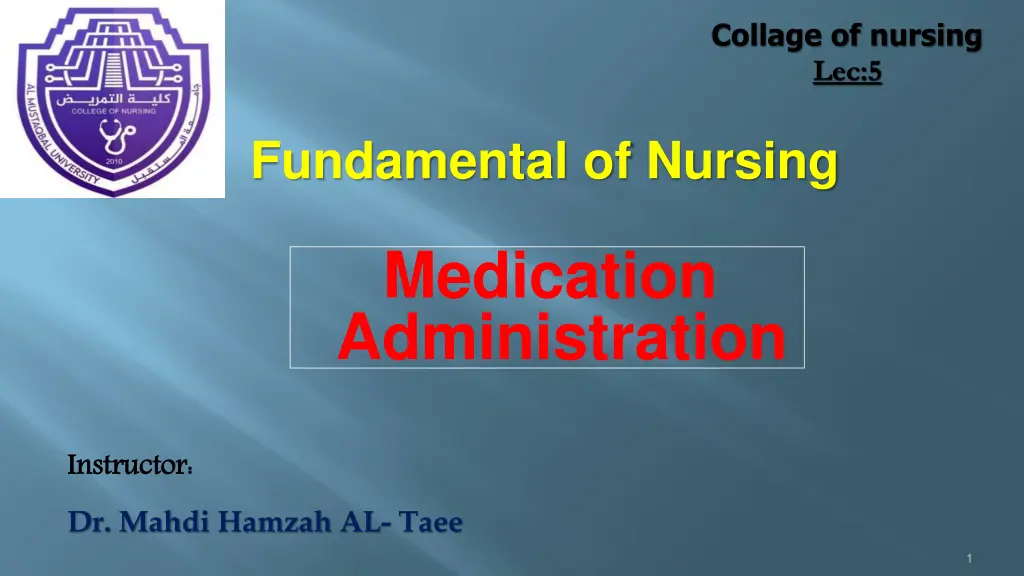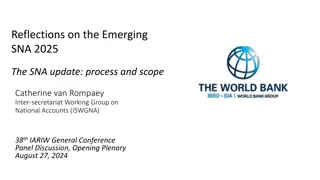
Nursing Medication Administration: Fundamentals and Effects Explained
Learn about medication administration in nursing, including drug types, effects, interactions, and administration methods. Explore the impact of developmental factors on medication effectiveness. Discover various forms of medications and their administration techniques. Enhance your knowledge for safe and effective patient care.
Download Presentation

Please find below an Image/Link to download the presentation.
The content on the website is provided AS IS for your information and personal use only. It may not be sold, licensed, or shared on other websites without obtaining consent from the author. If you encounter any issues during the download, it is possible that the publisher has removed the file from their server.
You are allowed to download the files provided on this website for personal or commercial use, subject to the condition that they are used lawfully. All files are the property of their respective owners.
The content on the website is provided AS IS for your information and personal use only. It may not be sold, licensed, or shared on other websites without obtaining consent from the author.
E N D
Presentation Transcript
Collage of nursing Lec:5 Fundamental of Nursing Medication Administration Instructor Instructor: : Dr. Mahdi Hamzah AL- Taee 1
Medication :substances administered for Dx, Rx ,cure ,relieve and prevention of diseases. Generic name (scientific name): drug name describe the chemical structures of the drug. Trade name (brand name): name given by the manufacturer. Prescription: written direction for the preparation and administration of medication 2
Therapeutic effect : the reason the drug prescribed. Side effect (adverse effect): the secondary effect of the drug that is unintended. Drug allergy: immunologic reaction to drug. Anaphylactic reaction: severe immediately after drug administration. Drug toxicity: deleterious effects of a drug on an organism or tissue, results from over dosage, buildup of the drug in the blood because of impaired metabolism or excretion. Drug interaction: occurs when the administration of one drug before, at the same time, or after another drug alter the effect of one or both drug. allergic reaction usually occur 3
Onset of action: the time after administration when the body initially responds to drug. 4
Developmental factors Pregnancy, and the effect of medication on the fetus. Physical changes due to aging. Gender: hormonal actions Diet Ex. Vitamin K and Warfarin Environment: Temperature Psychological factor Illness and disease 5
Tablets Pills Capsule Lozenge Syrup Aqueous suspension Cream Jells or jelly Lotion Ointment Paste suppositories 6
1.2 Sublingual Under tongue Used for general or local effect Under tongue Dissolved Largely absorbed in to blood stream 1.3 Buccal (cheeks) keep until Dissolved Same as oral under cheeks 8
Used when oral drug has objectionable taste or odor Release at slow steady rate Pt on the left lateral position with upper leg flexed Use lubricant Wear gloves insert suppositories beyond internal sphincter 10 cm 9
3.1 Dermatological preparation 3.2 Eye (Ophthalmic) instillation Eye Drops, Eye Ointment 10
Assist patient in side-lying position Clean the ear For children (under three years old) gently pull the pinna down and back For the adult pull the pinna upward and back ward to straighten the auditory canal. 12
Introduce drug through out respiratory tract Rapid localized relief Use only for respiratory system 13
Types Hypodermic syringe Insulin syringe (100 unit/ 1ml) Tuberculin syringe (1 ml) Regular syringe (5, 10, 20, and 50 ml) Prefilled unit-dose system 15
Needle characteristics Bevel (short/ long) Shaft (1/2- 2 inches) Gauge (diameter) = 18- 28 16
ID in to the dermal layer of the skin Small doses 0.1 ml Used for diagnostic purposes 15 degrees angle insertion of the needle The drug produce a bleb (wheal) Common site :inner aspect of the arm. upper chest, under scapula Do not massage the site of the injection Need time to interpret 17
Just under the skin usage Vaccination Insulin Heparin Only small doses(0.5-1ml) Needle size and length based on the patient body mass 45 degree angle of insertion 18
SQ injection sites need to be rotated to minimize tissue damage Common aspect of the upper arm, anterior aspect of the thigh, abdomen ,scapular area the ventrogluteal, dorsogluteal area sites: outer 19
Absorbed more quickly than SQ 1-2 ml used for less developed adult muscle Use safe site located away from large blood vessels, nerves and bone. 0.5-1 ml in the deltoid muscle Adult with well developed muscle 4 ml in the gluteal medius and gluteal maximus muscle 20
1. Deltoid Muscle 2. Vastus lateralis Muscle Z-track technique 3. Gluteal Muscle 21
Drug enter the blood stream directly For rapid effect is required Used when medication irritate the tissues Intravenous push Hazards effect is volume overload. Large volume of IV fluid Observe patient closely for signs of adverse reactions 22
Ampules Vials Single dose vial Multi dose vials Assignment Calculation 23
Withdrawing a medication from a vial that is held with the base down Withdrawing a medication from an inverted vial 24
Quantity in hand Dose in hand Desired quantity Desired dose 25
Be acknowledge about the medication you administer. Take the medication history Inform patient, explain action, give the side effect. Question the physician about any unclear order, high doses. Record the administration. Evaluate the patient response to the drug. Use only medication that are clearly labeled. Do not use liquid drug that are cloudy, change in color. Do not leave the medication at the bed side. 26
Right medication Right dose Right time (frequency) Right route Right patient Right documentation 27






















